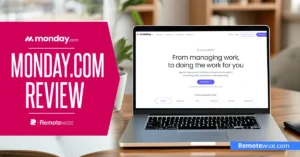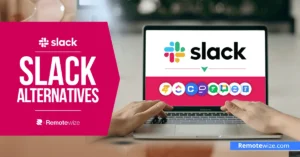As the world rapidly progresses into a more digital era, a rising number of professionals are working remotely. In fact, according to a study by Gallup, 43 percent of Americans work remotely at least some of the time. And that figure is only likely to rise.
So what does this mean for your business? It suggests that as a business manager, you should make preparations for a remote future. One way to do that is to build or update your remote work software stack.
This article will outline a complete software stack for managing a remote workforce. We will discuss recruitment software, communication tools, collaboration, payment processors, and more!
What Tech Stack Do You Need For Your Remote Workforce?
Here are some vital remote work tools:
1. Recruitment Software
The greatest asset of a company is its people. Attracting and hiring the best talent is essential for any business, but it can be a challenge – especially if you’re looking to hire remote employees. This is where recruitment software comes in.
The first piece of software you will need is a recruitment solution. This could be an Applicant Tracking System (ATS), a Human Resources Information System (HRIS), or even just a good ol’ spreadsheet. The crucial thing is that you have a system in place for tracking and managing job candidates. This will help you find the best candidates for your open positions, irrespective of location.
There are a number of excellent recruitment software options on the market, each with its own set of features. Some popular options include:
- JobVite: JobVite is a cloud-based recruitment solution that helps businesses identify, attract, and hire top talent. The platform offers a variety of features, including job postings, applicant tracking, candidate screening, and more.
- Greenhouse: Greenhouse is another popular recruitment software platform. Greenhouse offers many of the same features as JobVite, such as applicant tracking, candidate screening, and job postings. In addition, Greenhouse also offers a feature called “Greenhouse Scorecards” which allows managers to evaluate candidates based on specific criteria.
- Workable: Workable is an ATS and HRIS that helps businesses post jobs, track applicants, and manage employee information. It offers a variety of features, including applicant tracking, candidate management, job postings, and more.
- iCIMS: iCIMS is a cloud-based recruitment software platform that helps businesses attract, hire, and onboard top talent. It offers a variety of features, including applicant tracking, candidate screening, onboarding, and more.
2. Communication Tools
Effective communication is key to any successful business – remote or otherwise, which makes it the next piece of the puzzle. After all, how can you manage a remote team if you can’t communicate with them.
In order to manage a remote workforce effectively, clear and consistent communication is essential. There are a number of different communication tools available, each with its own set of features. Some popular options include:
- Slack: Slack is a cloud-based communication platform that helps teams manage conversations and stay connected. It offers a variety of features, including group chat, direct messaging, file sharing, and more.
- HipChat: HipChat is another popular communication tool that helps teams stay connected. It offers many of the same features as Slack, such as group chat, direct messaging, file sharing, and more.
- Zoom: Zoom is a cloud-based video conferencing platform that helps teams stay connected. It offers a variety of features, including group chat, file sharing, screen sharing, and more.
- Google Hangouts: Google Hangouts is a communication platform that helps teams stay connected via video call, voice call, or instant messaging. It offers a variety of features, including group chat, video call, voice call, and more.
- Microsoft Teams: Microsoft Teams is a communication and collaboration platform that helps teams stay connected. It offers a variety of features, including group chat, file sharing, screen sharing, and more.
- GoToMeeting: GoToMeeting is a cloud-based meeting platform that helps teams stay connected. It offers a variety of features, including group chat, screen sharing, and more.
3. Employee Management Software
Managing employees is a crucial part of any business. But when you have a remote workforce, it can be a challenge to keep track of employee hours, vacation days, sick days, and more. This is where employee management software comes in.
Employee management software is a platform that helps businesses manage their employees. It offers a variety of features, including time tracking, vacation tracking, sick day tracking, and more.
Some popular employee management software options include:
- Harvest: Harvest is a cloud-based time tracking platform that helps businesses track time, manage projects, and invoicing. It offers a variety of features, including time tracking, project management, invoicing, and more.
- ClickTime: ClickTime is another popular time-tracking platform that helps businesses track time, manage projects, and invoicing. It offers a variety of features, including time tracking, project management, invoicing, and more.
- TimeDoctor:
Other than managing your employees, you need software that helps you keep track of their work, manage projects, and collaborate with them. Some popular project management tools include:
- ClickUp:
- Asana: Asana is a cloud-based project management platform that helps businesses manage projects, tasks, and deadlines. It offers a variety of features, including task management, project management, team collaboration, and more.
- Trello: Trello is another popular project management platform that helps businesses manage projects, tasks, and deadlines. It offers a variety of features, including task tracking, file sharing, team collaboration, and more.
- Basecamp: Basecamp is a cloud-based project management platform that helps businesses manage projects, tasks, and deadlines. It offers a variety of features, including task management, file sharing, team collaboration, and more.
4. Payment Software
Paid employees are the lifeblood of any business. But how do you pay your remote employees? There are a number of different payment processors available, each with its own set of features. Some popular options include:
- Payoneer: Payoneer is a global payment platform that helps businesses pay their employees. It offers a variety of features, including direct deposit, local bank transfer, international wire transfer, and more.
- TransferWise: TransferWise is another popular payment processor that helps businesses pay their employees. It offers many of the same features as Payoneer, such as direct deposit, local bank transfer, international wire transfer, and more.
- PayPal: PayPal is a popular payment processor that offers a variety of features, including online payments, mobile payments, invoicing, and more.
- Stripe: Stripe is another popular payment processor that offers many of the same features as PayPal, such as online payments, mobile payments, invoicing, and more.
- Braintree: Braintree is a payment processor that offers a variety of features, including online payments, mobile payments, invoicing, and more.
4. Dismissal Process
No business is immune to the occasional bad apple. When it comes to managing a remote workforce, dismissal can be a bit more complicated than it is for traditional businesses. There are a number of different software available to assist with the dismissal processes, each with its own set of features.
Employee record management software is a type of software that helps businesses manage employee records. It offers a variety of features, including applicant tracking, job postings, performance management, and more. When it comes to employee dismissal, this type of software can be a valuable tool, since it provides evidence that acts as grounds for dismissal. Some popular options include:
- Gusto: Gusto is a cloud-based software that helps businesses manage employee records. It offers a variety of features, including applicant tracking, job postings, performance management, and more.
- BambooHR: BambooHR is another popular cloud-based software that helps businesses manage employee records. It offers many of the same features as Gusto, such as applicant tracking, job postings, performance management, and more.
- Zenefits: Zenefits is a cloud-based software that helps businesses manage employee records. It offers a variety of features, including applicant tracking, job postings, performance management, and more.
Remote Work SoftWare Stacks Used By Top Distributed Teams
Different companies use different software to manage their remote workforces. Here is a list of some popular software used by top distributed teams:
Automattic
Automattic is a team-distributed firm with over 1900 employees spread over 95 countries. They are the creators of WordPress.com, Tumblr, Jetpack, Longreads, WooCommerce, and other services.
Given their years in operation, they have had lots of experience selecting the ideal software to operate as a fully-remote organization. The company has even launched Happy Tools, a package of in-house tools designed for businesses with remote or globally scattered staff.
Management was concerned about how Automattic’s distributed teams strategy would adapt as the firm grew. Automattic’s present set of tools and software is the result of more than a decade of experimenting, with convenience being a crucial criterion for selection.
Here is a list of the software and tools they use:
- Zoom
- Slack
- Wiki
- P2 (a WordPress theme)
Zapier
Zapier is a completely distributed team, with 300 individuals operating in 27 countries worldwide. Over 2 million people have registered with the company. Since its inception in 2011, Zapier has operated exclusively remotely.
As Zapier evolved from three founders to over 300 individuals working remotely, they discovered that the three critical ingredients to doing remote work successfully are tools, team, and process. They selected remote work technologies to facilitate communication and to assist their procedures.
Some tools used by the Zapier team include:
- Slack
- Trello Editorial Calendar board
- Google Docs
- Google Calendar
- Async (an internal tool they built)
- Hackpad
- RecordIt
- Zoom
- Screenflow
- GitHub
- 1Password
- Quip
- HelpScout
Buffer
Buffer supports over 75,000 customers through a globally scattered staff of dozens of people who live and work in over 15 countries.
Employees receive computers, Kindles, and annual team-wide retreats all through the year for smaller teams. Their technologies solve the issue of transparent, streamlined communication by ensuring that people have access to all the information they require when they require it.
Here is the tools and software used by Buffer:
- Trello
- Speak.io
- Wunderlist
- iDoneThis
- Hackpad
- Cloud App
- Jawbone Up
- World Time Buddy
- Notion
- Threads
- Zenefits
- Okta and 1Password
- Timetastic
- Culture Amp
- Slack
- HeyTaco
- Dropbox
- Calendly
Build An Effective Remote Software Stack
When it comes to managing a remote workforce, the software stack you use is a great determinant of success. The right software can help you manage your recruitment, communication, payment, and dismissal processes with ease. We have covered some examples of some of the best tools and software distributed teams are using to stay connected and productive.
There is no one-size-fits-all solution when it comes to the best remote work software stack. By carefully selecting the right tools for your business, you can create a smooth and efficient workflow that will help you manage your remote employees effectively. Make managing your remote workforce a breeze with the right tech tools.



